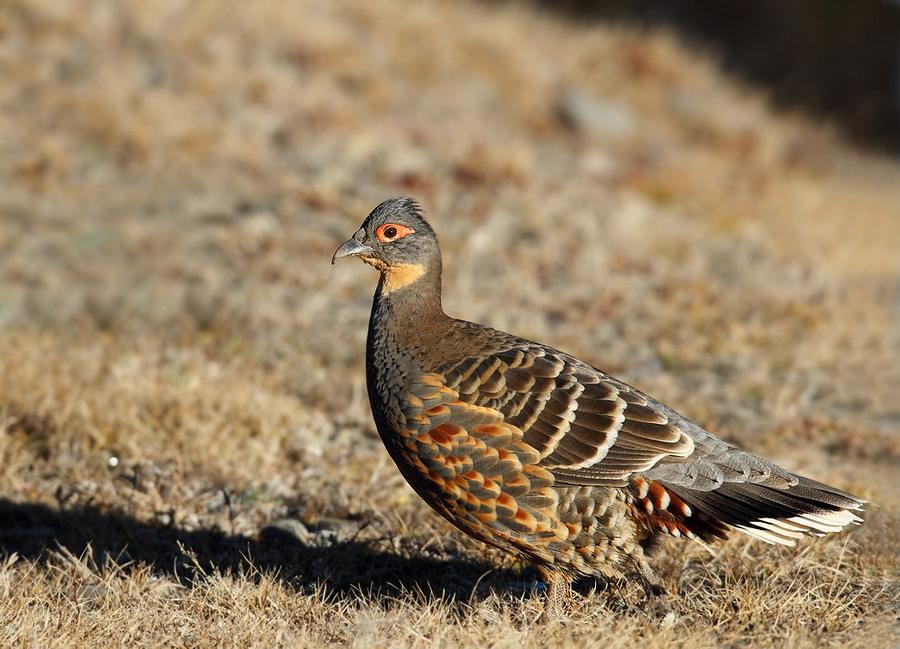Tetraophasis szechenyii
IUCN
LCBasic Information
Scientific classification
- name:Tetraophasis szechenyii
- Scientific Name:Yellow-throated pheasant, Sichuan pheasant quail, sheep-horn chicken,Tetraophasis szechenyii,Buff-throated Partridge,Szechenyi's Monal-Partridge
- Outline:Landfowl
- Family:Galliformes Phasianidae
Vital signs
- length:43-49cm
- Weight:800-1500g
- lifetime:No verification information
Feature
There is a hint of yellow in the throat, and it will keep calling before the rain or snow.
Distribution and Habitat
Distributed in northeastern India, eastern Himalayas and southwestern China.
In China, it is mainly distributed from Kangding to Batang in western Sichuan, south of Yushu in Qinghai to northwestern Yunnan, and west to Mangkang, Chaya, Jiangda, Qamdo, Leiwuqi, Zuogong, Bomi, Nyingchi, Milin, Langxian and other places in Tibet. During the breeding period, the yellow-throated pheasant quail mainly inhabits coniferous forests, alpine rhododendron bushes and rocky tundra areas above the forest line at an altitude of about 3500-4500 meters. In winter, it can go down to mixed forests and forest edges below 3500 meters.
Appearance
The body feathers of the Yellow-throated Pheasant are mostly gray-brown, with dark-brown central stripes on the top of the head and the nape, especially the longitudinal stripes on the nape are wider. The wings are slightly rounded with white or light brown spots on them. There are 18 tail feathers, which are wedge-shaped. The central pair of tail feathers are gray-brown with white and black-brown worm-like terminal spots. The base of the outer tail feathers is gray-brown with black-brown spots, and the ends are dark black with white terminal spots. The base color of the chest is mostly light gray. The center of the abdomen is brownish white, sometimes mixed with chestnut. The chin, throat and front neck are leather yellow with white edges on both sides. The coverts under the tail are also red chestnut. The male bird has spurs. The iris is brown; the bill is slightly black; the feet are dark red.
The plumage of male and female birds is similar and similar to that of the Red-throated
Details
The foreign name of the yellow-throated pheasant quail is Buff-throated Partridge or Szechenyi's Monal-Partridge. It has no subspecies and is a rare resident bird.

Yellow-throated pheasant quail roosts on low branches at night. Except for the breeding season when they mostly move in pairs or alone, they mostly move in small groups at other times. They mainly move on the ground in the forest. They are good at walking and running on the ground, but not good at flying. Except in critical situations, they rarely take off, and the distance they fly each time is not large, mostly a few meters to tens of meters. They mainly feed on roots, leaves, buds, fruits and seeds of plants, and also eat a small amount of insects. More than 20 kinds of food have been recorded.
Yellow-throated pheasant quail likes to sing, often starting at dawn, first one or two first sing, followed by a flock of birds singing together, the call is loud and noisy, and it can be heard far away in the deep mountains and valleys. Whenever fog or rain and snow are about to come, their calls become more frequent, so the local Tibetan and Qiang residents have such a saying: "When the sheep-horn chicken calls, it will rain if it is not cloudy", and use it to predict weather changes. Sheep horns are the local name for the azalea plant, and sheep-horn chicken refers to the yellow-throated pheasant quail living in the azalea bushes.
The breeding season of the Yellow-throated Pheasant Quail is from May to July. The nest is built under rocks on the ground or on small shrubs. The nest is relatively hidden, with a diameter of 20-25.5 cm and a depth of 4.7-5.2 cm. Each nest lays 3-7 eggs. The color of the eggs is white with red and brown spots. The shape of the eggs is oval, the size is 51-53×33-34 mm, and the egg weight is 32-34 grams. The female bird is responsible for incubation. The feathers of the newly born chicks are grayish white, with a brown-black vertical stripe in the middle of the back, a pure white stripe on each side of the body, and white around the eyes.
The global population size of the Yellow-throated Pheasant Quail has not been quantified, but the species is described as not uncommon in the local area. It is generally considered uncommon and is very rare locally in India, but is thought to remain widespread in the Chinese part of its range. The population in eastern Tibet is estimated at 25,000-40,000 (Madge and McGowan 2002).
Listed in the IUCN Red List of Threatened Species 2016 ver3.1 - Least Concern (LC).
Listed in China's National Key Protected Wildlife List (February 5, 2021) at level 1.
Protect wildlife and eliminate game.
Maintaining ecological balance is everyone's responsibility!








